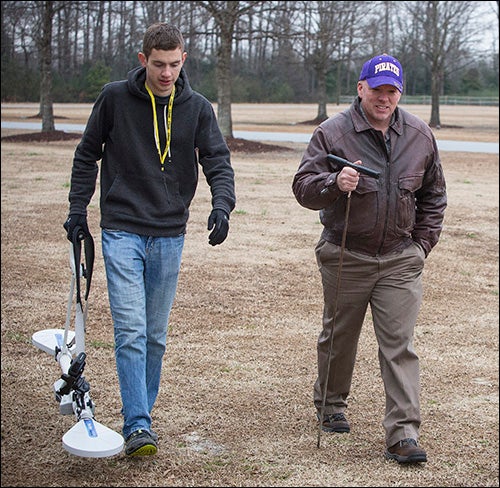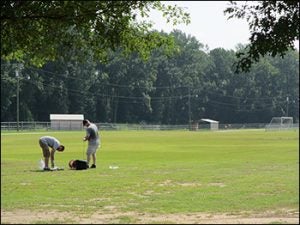‘EMERGING CONTAMINANTS’
Scientists study septic systems for chemical traces
Endocrine Disruption a Growing Threat
Exposure to low-levels of some contaminants can cause disruption of endocrine functions, such as reproduction, in animals.
This disruption occurs when the contaminants modulate, mimic or interfere with normal hormonal activity. Examples of endocrine-active contaminants are chemicals such as synthetic hormones, certain pesticides, some pharmaceuticals, detergent degradation products such as nonylphenol, and many others.
Among aquatic life, one example of endocrine disruption is intersex, or the presence of male and female characteristics within the same fish. Experts are observing this abnormality in fish in streams across the nation, according to the U.S. Geological Survey. Endocrine disruption can result in adverse effects on the development of the brain and nervous system, the growth and function of the reproductive system and the response to stressors in the environment. These disruptions can have ruinous impacts on fish populations.
For example, a 2008 Colorado study showed the population of fish downstream of wastewater discharge from a sewage treatment plant was dominated by females, and 18 to 22 percent of fish exhibited intersex.
Another 2008 study documented complex effects of fish exposure to nonylphenol, a degradation product used in large quantities in commercial and household detergents. Scientists reported in the journal Aquatic Toxicology that low doses of nonyphenol “primed” the males for breeding competition, whereas higher exposures inhibited their breeding behavior.
Another product found in ground and surface water, bisphenol A, has been linked to the early onset of puberty in laboratory animals, according to a 2009 study published in Environmental Health Perspectives. BPA is commonly found in plastic bottles, containers and even the linings of metal and infant formula food cans, though it was banned from baby bottles in 2012.
The ubiquitous presence of these synthetic compounds and their effects on life are one reason ECU researchers are taking a closer look at septic systems in eastern North Carolina.
“If (organisms) are exposed to these compounds from the time they are conceived to the time they are ready to reproduce, that’s their entire developmental process,” said Jamie DeWitt, an assistant professor of pharmacology and toxicology at the Brody School of Medicine at ECU.
In rural eastern North Carolina, septic systems are the primary way sewage is treated. While the systems are simple yet effective, some experts now wonder if the systems and the rules governing their installation are sufficient to keep ground and surface water clean from the modern synthetic chemicals found in common products and medicines.
That’s what a group of 10 East Carolina University researchers is working to find out. Geologists, toxicologists, engineers and others are studying “emerging contaminants” in coastal waters, particularly pharmaceutical and personal care product pollutants, or PPCPs, how they move from septic systems and what health risks they might present to humans and other organisms.
PPCPs range from prescription drugs such as birth control pills to some of the ingredients in soap and shampoo – even coffee and soft drinks get included since they contain caffeine. While the environmental effects of caffeine aren’t known, other PPCPs contain endocrine disrupters and other compounds that are known to adversely affect aquatic life once they reach surface water.

ECU geologist Mike O’Driscoll checks water for contaminants.
“The reason they’re ending up in the waste stream is our bodies excreting them after we use the pharmaceutical or consumer product,” said Siddhartha Mitra, associate professor of geology and one of the leaders of the research group. “You don’t want endocrine disrupters, even at low levels, in the environment. Even at the low levels we’re seeing in the environment, those endocrine disruptors can have drastic effects on the ecosystem.”
Many municipal water treatment facilities, such as Greenville Utilities’ complex off Old River Road, have advanced processes to remove these products from wastewater. But home septic systems do not. With approximately 40 septic systems per square mile in eastern North Carolina – more in densely populated areas, such as waterfronts – that’s a lot of potentially undertreated sewage.
“It’s not like an oil spill where there’s a huge amount that comes in at once,” Mitra said. “It’s actually quite the opposite. We’re just getting to the point we’re realizing this is a big problem with septic systems.”
He and two other researchers working on this project, environmental health specialist Charlie Humphrey and geologist Mike O’Driscoll, published an article in July describing the detection of PPCPs in groundwater (“Detection of pharmaceuticals and other personal care products in groundwater beneath and adjacent to onsite wastewater treatment systems in a coastal plain shallow aquifer,” published in Science of the Total Environment).
In that study, which involved home septic systems in the Eastern Pines area of Pitt County, caffeine, the insecticide DEET, homosalate, which is found in sunscreen products, and the painkiller ibuprofen were the PPCPs most frequently detected across all study sites in August and November 2012. Thirty-two of 37 samples, or 87 percent, had detectable levels of at least one of the target PPCPs. DEET was the compound most frequently detected (78 percent) in groundwater, tank and stream samples combined, followed by ibuprofen (38 percent), caffeine (35 percent) and homosalate (19 percent).

Geology graduate student Adam Trevisan, left, and environmental health specialist Charlie Humphrey carry tools to a site for research.
Concentrations of these PPCPs were detected most frequently in the tank samples followed by up-gradient samples, drainfield samples and down-gradient samples. Due to the presence of these PPCPs and the movement of ibuprofen 15-18 meters from the drainfield to a nearby stream, the scientists said setback distance regulations might not be adequate.
“One system might not be a problem, but if you look at all of them, there could be issues,” O’Driscoll said.
The aim now is to better gauge the pervasiveness of PCPPs moving from septic systems, also known as onsite wastewater treatment systems, to surface water, how to determine if the PCPPs are entering aquatic organisms and what rules might be necessary to prevent PCPPs from reaching waters.
“Everything you put down your drain could potentially end up in our environment,” said Jamie DeWitt, an assistant professor of pharmacology and toxicology at the Brody School of Medicine at ECU. “It’s what we eat, it’s what we drink, it’s what we wash with. We don’t know what chronic or long-term exposure to low concentrations of these products does.
Departments represented
Arts and Sciences
Geography
Engineering
Geology
Biology
Chemistry
Health and Human Performance
Environmental health
Brody School of Medicine
Pharmacology and Toxicology
Pictured below, ECU researchers gather water samples in Craven County.

“This is an important concern for coastal North Carolina as the density of septic systems is quite high and because our coastal resources are critically important to many aspects of our state’s well-being,” she said.
Burrell Montz, professor and chair of geography, is working on mapping the density and type of septic systems. She predicts the group’s findings might not please developers and municipal leaders but will provide facts to base future decisions on.
“You need good science to get good policy,” she said. “If we know what to anticipate, then maybe we can make better decisions. My hunch is it’s not going to be pretty, which means we have to be careful how we present it.”
Among the potential solutions for more comprehensive sewage treatment are advanced septic systems, such as those with permeable reactive barriers, which could serve a single residence or a group of houses. But they aren’t cheap.
“It could cost you $40,000 to get a new advanced system,” said O’Driscoll. “It would start to turn the little septic system in your backyard into something like the municipal treatment system.”
The group has received funding from the ECU Division of Research and Graduate Studies program to foster scientific collaboration between the main and health sciences campuses. They are working to generate data to submit with proposals for external grants.
Traditionally, it’s been unusual for this many researchers from so many departments to work together on a single issue. But this issue covers a lot of ground.
“We consider ourselves a truly transdisciplinary team as we have to work together to understand this problem,” DeWitt said. “One piece of the puzzle isn’t enough.
“I love working with this team. It forces me to think outside my own scientific box.”
